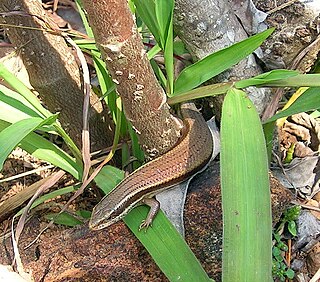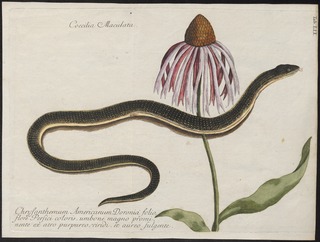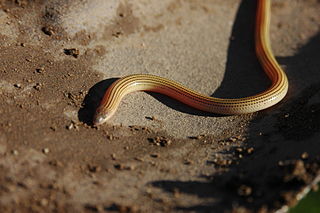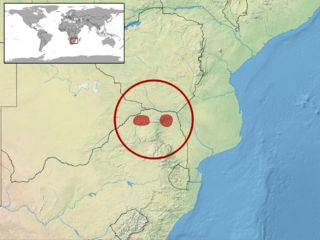Acontias is a genus of limbless skinks, the lance skinks, in the African subfamily Acontinae. Most are small animals, but the largest member of the genus is Acontias plumbeus at approximately 40 cm (16 in) snout-vent length. All members of this genus are live-bearing sandswimmers, with fused eyelids. A recent review moved species that were formerly placed in the genera Typhlosaurus, Acontophiops, and Microacontias into this genus, as together these form a single branch in the tree of life. This new concept of Acontias is a sister lineage to Typhlosaurus, and these two genera are the only genera within the subfamily Acontinae.

Scelotes is a genus of small African skinks.

Typhlosaurus is a genus of African lizards, one of a number of genera of limbless lizards in the skink family (Scincidae). This group was recently revised with most species formerly attributed to Typhlosaurus now placed in Acontias. The current definition of Typhlosaurus includes five attenuate body legless lizards from southwestern Africa. This is the sister genus to Acontias, which together form the well supported Afrotropical subfamily Acontinae.

Acontias breviceps, the shorthead lance skink or shortheaded legless skink, is a species of viviparous, legless, fossorial lizards occurring along the southern and eastern sections of the Great Escarpment in South Africa. It may grow up to 10 cm long.

Acontias percivali, also known commonly as Percival's lance skink, Percival's legless lizard, and the Tanzanian legless lizard, is a species of small, legless (snake-like) lizard in the family Scincidae. The species is endemic to Africa.

The woodbush legless skink is a species of legless skink. It is found in the Wolkberg mountains of Limpopo Province, South Africa. Females of the species give birth to live young. This lizard species was formerly placed in a monotypic genus as Acontophiops lineatus. Morphologically the genus shows similarities to Acontias cregoi and a recent review placed both of these within the genus Acontias, which, as Acontias lineatus was already occupied, required a new name for this species.
Kasner's dwarf burrowing skink, also known commonly as Kasner's burrowing skink, is a species of lizard in the family Scincidae.

Lygosominae is the largest subfamily of skinks in the family Scincidae. The subfamily can be divided into a number of genus groups. If the rarely used taxonomic rank of infrafamily is employed, the genus groups would be designated as such, but such a move would require a formal description according to the ICZN standards.

Acontias meleagris, the Cape legless skink, is a species of skink found in the southern Cape of South Africa. It has no limbs, like most members of the subfamily Acontinae.
Acontias aurantiacus, the golden blind legless skink, is a species of lizard in the family Scincidae. It is found in Zimbabwe, Mozambique, Botswana, and South Africa.

Acontias cregoi, commonly known as Cregoe's legless skink, Cregoi's blind legless skink, and Cregoi's legless skink, is a species of lizard in the family Scincidae. The species is endemic to South Africa.
Acontias fitzsimonsi, Fitzsimons' legless skink or Fitzsimon's legless skink, is a species of lizard in the family Scincidae. It is endemic to South Africa.
Acontias grayi, Gray's dwarf legless skink, is a species of lizard in the family Scincidae. It is endemic to Western Cape, South Africa.
Acontias litoralis, the coastal dwarf legless skink or coastal legless skink, is a species of lizard in the family Scincidae. It is endemic to South Africa.
Acontias namaquensis, the Namaqua legless skink or Namaqua lance skink, is a species of lizard in the family Scincidae. It is endemic to Little Namaqualand, Northern Cape, South Africa.

Acontias orientalis, the Eastern striped blindworm or Eastern Cape legless skink, is a species of lizard in the family Scincidae. It is endemic to South Africa.

Acontias plumbeus, the giant legless skink or giant lance skink, is a species of lizard in the family Scincidae. It is found in South Africa, Eswatini, Mozambique, and Zimbabwe.

Acontias richardi, Richard's legless skink, is a species of lizard in the family Scincidae. It is endemic to South Africa.
Acontias tristis, the Namaqualand dwarf legless skink, is a species of lizard in the family Scincidae. It is endemic to South Africa.
Feylinia currori, also known commonly as Curror's skink, the western forest feylinia, and the western forest limbless skink, is a species of lizard in the family Scincidae. The species is indigenous to Central Africa.












